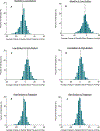Advances in Genomics Research of Blood Pressure Responses to Dietary Sodium and Potassium Intakes
- PMID: 33993724
- PMCID: PMC12276891
- DOI: 10.1161/HYPERTENSIONAHA.121.16509
Advances in Genomics Research of Blood Pressure Responses to Dietary Sodium and Potassium Intakes
Abstract
More than half of US adults have hypertension by 40 years of age and a subsequent increase in atherosclerotic cardiovascular disease risk. Dietary sodium and potassium are intricately linked to the pathophysiology of hypertension. However, blood pressure responses to dietary sodium and potassium, phenomena known as salt and potassium sensitivity of blood pressure, respectively, are heterogenous and normally distributed in the general population. Like blood pressure, salt and potassium sensitivity are complex phenotypes, and previous research has shown that up to 75% of individuals experience a blood pressure change in response to such dietary minerals. Previous research has also implicated both high salt sensitivity and low salt sensitivity (or salt resistance) of blood pressure to an increased risk of hypertension and potentially atherosclerotic cardiovascular disease risk. Given the clinical challenges required to accurately measure the sodium and potassium response phenotypes, genomic characterization of these traits has become of interest for hypertension prevention initiatives on both the individual and population levels. Here, we review advances in human genomics research of blood pressure responses to dietary sodium and potassium by focusing on 3 main areas, including the phenotypic characterization of salt sensitivity and resistance, clinical challenges in diagnosing such phenotypes, and the genomic mechanisms that may help to explain salt and potassium sensitivity and resistance. Through this process, we hope to further underline the value of leveraging genomics and broader multiomics for characterizing the blood pressure response to sodium and potassium to improve precision in lifestyle approaches for primordial and primary atherosclerotic cardiovascular disease prevention.
Keywords: blood pressure; cardiovascular disease; diet; hypertension; sodium.
Conflict of interest statement
Conflicts of Interest
The authors have no financial disclosure or conflicts of interest to report.
Figures


Similar articles
-
Replacing salt with low-sodium salt substitutes (LSSS) for cardiovascular health in adults, children and pregnant women.Cochrane Database Syst Rev. 2022 Aug 10;8(8):CD015207. doi: 10.1002/14651858.CD015207. Cochrane Database Syst Rev. 2022. PMID: 35944931 Free PMC article.
-
Dietary Approaches to Stop Hypertension (DASH) for the primary and secondary prevention of cardiovascular diseases.Cochrane Database Syst Rev. 2025 May 6;5(5):CD013729. doi: 10.1002/14651858.CD013729.pub2. Cochrane Database Syst Rev. 2025. PMID: 40326569 Review.
-
Management of urinary stones by experts in stone disease (ESD 2025).Arch Ital Urol Androl. 2025 Jun 30;97(2):14085. doi: 10.4081/aiua.2025.14085. Epub 2025 Jun 30. Arch Ital Urol Androl. 2025. PMID: 40583613 Review.
-
Dietary Potassium Intake Remains Low and Sodium Intake Remains High, and Most Sodium is Derived from Home Food Preparation for Chinese Adults, 1991-2015 Trends.J Nutr. 2020 May 1;150(5):1230-1239. doi: 10.1093/jn/nxz332. J Nutr. 2020. PMID: 31909790 Free PMC article.
-
Effect of longer-term modest salt reduction on blood pressure.Cochrane Database Syst Rev. 2013 Apr 30;2013(4):CD004937. doi: 10.1002/14651858.CD004937.pub2. Cochrane Database Syst Rev. 2013. PMID: 23633321 Free PMC article.
Cited by
-
Associations of E-proteinoid 3 receptor genetic polymorphisms with salt sensitivity, longitudinal blood pressure changes, and hypertension incidence in Chinese adults.J Clin Hypertens (Greenwich). 2024 Aug;26(8):955-963. doi: 10.1111/jch.14859. Epub 2024 Jul 1. J Clin Hypertens (Greenwich). 2024. PMID: 38952049 Free PMC article.
-
Modifiable lifestyle factors in the primordial prevention of hypertension in three US cohorts.Eur J Intern Med. 2025 Feb;132:55-66. doi: 10.1016/j.ejim.2024.10.028. Epub 2024 Nov 6. Eur J Intern Med. 2025. PMID: 39505681
-
Kidney omics in hypertension: from statistical associations to biological mechanisms and clinical applications.Kidney Int. 2022 Sep;102(3):492-505. doi: 10.1016/j.kint.2022.04.045. Epub 2022 Jun 9. Kidney Int. 2022. PMID: 35690124 Free PMC article. Review.
-
Differential influences of serum vitamin C on blood pressure based on age and sex in normotensive individuals.Front Nutr. 2022 Nov 29;9:986808. doi: 10.3389/fnut.2022.986808. eCollection 2022. Front Nutr. 2022. PMID: 36523333 Free PMC article.
-
Association between rs4673 and blood pressure response to acute saline infusion in Chinese population.Medicine (Baltimore). 2025 Feb 14;104(7):e41463. doi: 10.1097/MD.0000000000041463. Medicine (Baltimore). 2025. PMID: 39960941 Free PMC article.
References
-
- Egan BM, Kjeldsen SE, Grassi G, Esler M, Mancia G. The global burden of hypertension exceeds 1.4 billion people. J Hypertens. 2019;37:1148–1153. - PubMed
-
- Virani SS, Alonso A, Benjamin EJ, Bittencourt MS, Callaway CW, Carson AP, Chamberlain AM, Chang AR, Cheng S, Delling FN, Djousse L, Elkind MSV, Ferguson JF, Fornage M, Khan SS, Kissela BM, Knutson KL, Kwan TW, Lackland DT, Lewis TT, Lichtman JH, Longenecker CT, Loop MS, Lutsey PL, Martin SS, Matsushita K, Moran AE, Mussolino ME, Perak AM, Rosamond WD, Roth GA, Sampson UKA, Satou GM, Schroeder EB, Shah SH, Shay CM, Spartano NL, Stokes A, Tirschwell DL, VanWagner LB, Tsao CW, Wong SS, Heard DG. Heart disease and stroke statistics—2020 update: A report from the American Heart Association. Circulation. 2020;141:e139–e596. - PubMed
Publication types
MeSH terms
Substances
Grants and funding
LinkOut - more resources
Full Text Sources
Other Literature Sources
Medical

